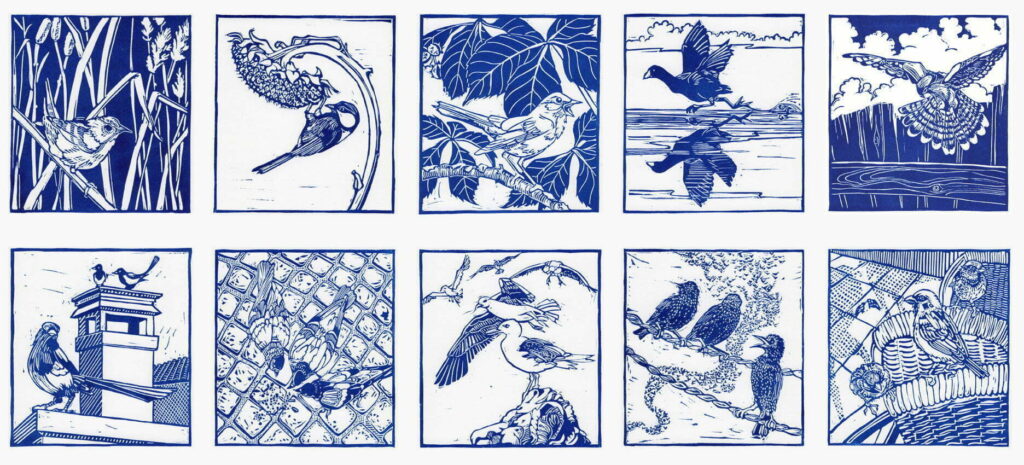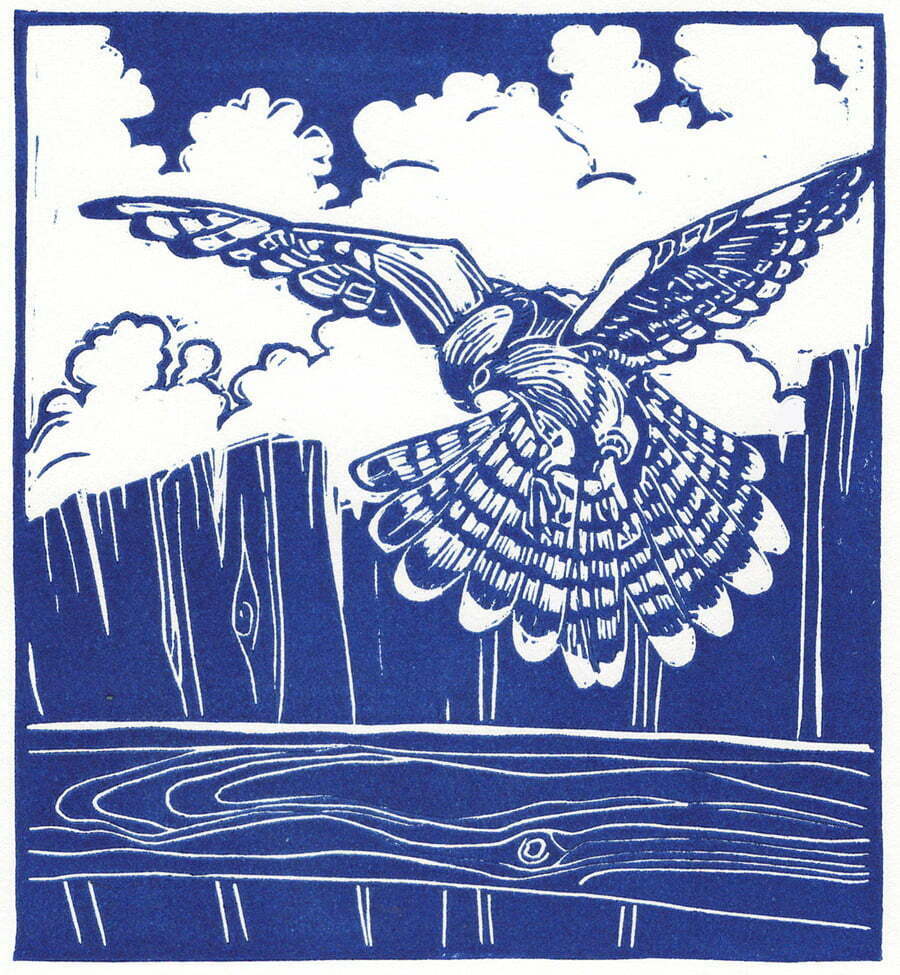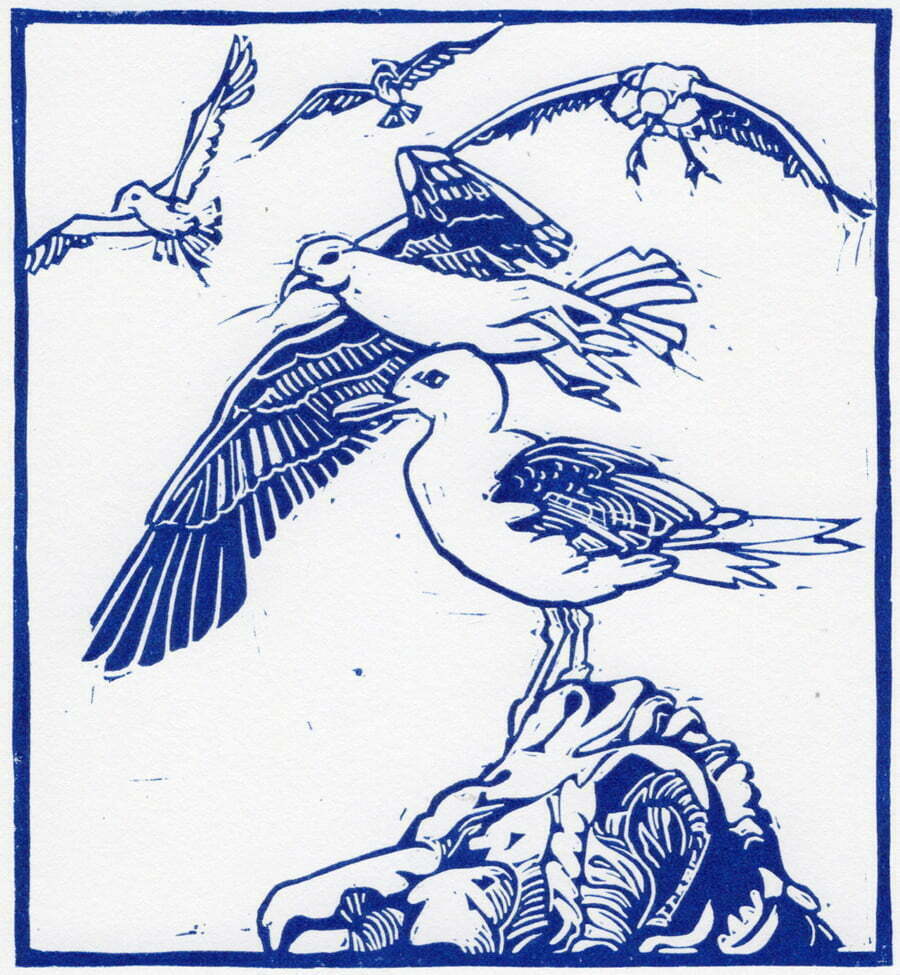
This second “Confinement” has given me an excellent opportunity to complete 2 sets of linogravure pieces. As I mentioned in an earlier post, I have become interested in the specificity of birds—each species with its own perfect set of adapters—beak shape, body build, flying pattern and everything that makes it perfect for how it goes about surviving.
My first set of prints is of the birds everyone appreciates—for their cuteness, majesty, or song.

The wren, I think, is the cutest of birds. Wrens are tiny (app. 10cm), with perky little tails that they usually set at a 90° (or less!) angle from their bodies. We had a birdhouse, when I was a kid, that was designed just for these little guys—with an opening so small, other species couldn’t move in. The ones we see here in France are called “Troglodyte Mignon”.

This is a representation of the Mesange Charbonnière which I have only seen here in France (you can read about my encounters with them on my balcony, along with their cousins, the Mesanges bleues). In America, their closest relatives are the chickadees, whose behavior is similar—like the wren, another avian cutie.

I hear nightingales (you can see where I got my reference) quite frequently here in Provence. Their song is complex and long. A few times, coming home from a tango evening at 2:00 am (those days seem a long time ago in these Covid times), I hung around my parking lot just to listen. I’m not sure whether the bird was singing because the streetlight made it believe it was daytime, or, as its name suggests, it sings at night (like the American mockingbird, which has kept me up on a night). In addition to the odd timing, the occasions I heard a nightingale at night, it was January.

Most recently, I spotted the blue-legged coot on my little excursion to the Camargue bird sanctuary. The American coot and the Eurasian coot look the same to this amateur birder. Coots also make it into my “Cute bird” category because of their endearing squeek-toy call.

Their diminutive size and big falcon-style eyes led me to choose the Kestrel for the fifth in the “Birds We Love” series. I used to see them a lot in semi-rural areas around San Francisco. There is a Eurasian variety of this bird, but I haven’t see it yet. These birds catch your eye with the flappy hovering they perform over fields and open spaces.
And now for the less popular—even despised birds. Isn’t it curious how we disdain the very creatures who best manage to adapt to human habitats?

Around here, the Magpie is really unpopular. They are noisy, smart, aggressive predators (remind you of another species?). They are fearless and, as the opera “The Thieving Magpie” suggests, steal bits of flashy detritus we leave around. I heard a story about a woman who had lost her ring to one of these guys, having laid it on a nearby windowsill whilst doing dishes. The following winter, when her husband was doing some pruning, he came upon a magpie nest, and lo and behold, in it was his wife’s ring!
Outside my apartment window live a few families of “Pies“. I like watching them flick their tails and fly around the hotel opposite. When they are nesting, they harass the poor kitty next door . But they are truly beautiful with a graphic look that could be the envy of any fashion designer.

The humble Rock Pigeon definitely makes in the Unappreciated category. I have heard them called “Rats with wings”. Here’s an interesting article with a theory of why people loathe them so much. The author, Colin Jerolmack, suggests that city dwellers hate pigeons because they cohabit our urban spaces, but don’t follow our rules. Unlike us city dwellers, they don’t respect private property, and defecate where they please. Maybe humans are just envious of their freedom. For sure, getting shat upon is annoying, but these birds are pretty harmless (their disease carrying is overstated). Their monogamy and obvious displays of affection should endear these birds to us. Some racing pigeons have enormous value (hundreds of thousands of dollars) for their uncanny ability to find their way home.

Another unpopular bird for some (especially those living on the coast) is the seagull. There are many different varieties of this bird, but here I depict the one the French call the Goeland, (American equivalent is the Herring Gull).
Even though I live 30 kilometers from the sea, I see plenty of seagulls hanging around my neighborhood. Yes they are scavengers (a sorry sight is seeing them feasting on cheese doodles). And, like the magpie, it’s an aggressive bird. How else could it thrive so well among us humans?
At the Gare St Charles, in Marseille, are 19th-century sculptures celebrating (embarrassingly) the glories of the old French colonies. Among them is this lion, on which disrespecting goelands often perch.

The European Starling (here they’re called, étourneaux, which means insignificant, useless persons ) is an invasive species in North America, so it makes the NG bird list. But every November we are treated to the spectacle of their Murmurations as they migrate south. Enormous, noisy flocks pass through Aix and cover the trees as they settle for the night. These birds have gorgeous, iridescent plumage. And like the other birds I’ve put in the unpopular list, they are clever, funny and not shy.

The last underappreciated bird is the common House Sparrow (Moineau). Some people think they are cute, but their ubiquitous-ness makes them under appreciated. The American ones, as in the cases of the starlings and pigeons, were European imports. Their humble appearance, along with their familiarity, breeds contempt, alas. But, like the common ailanthus tree, sparrows bring a bit of nature to the seediest urban neighborhoods, and for that they deserve a bit of thanks.

Fantastic and beautiful
¡Este encierro parece darte alas! mi querida artista, aunque pienso que las alas de tu imaginación, tu curiosidad, tu creatividad, son tus compañeras desde hace mucho mucho tiempo.
¡Enhorabuena! Además de despertarnos la curiosidad ornitológica, me has ayudado a desempolvar mis rudimentos de inglés (hay frases que aún con el diccionario no comprendo)….
Gracias por compartirnos tu afilada mirada.
Rosa
Gracias Rosa para tus palabras amables!
Magnífico trabajo Diana, delicado y didáctico!
Y con ese toque personal tuyo tan próximo de la naturaleza
En efecto, a pesar de este período tan incierto, sigues estando inspirada
Besos
These are all beautiful compositions and skilled drawings – seems like it would be difficult to achieve in this medium. Also feel very Japanese. Like your use of the limited palette of blue on white paper. Great info snippets. And I DO like the pigeon image a good deal. My grandfather raised pigeons in Pittsburgh. We now have a bird feeder for humming birds. So much fun to observe them. In fact we spend a lot of time looking at the birds out our window, especially the soaring hawks.
Wonderful artworks Diana – I’ve so enjoyed having a look – you are very talented indeed!
Yet another wonderful result being in lockdown. I do hope you’re continuing to produce more great art.
Kind regards from Western Australia.
Fiona